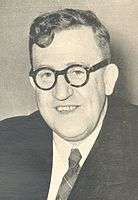Australian federal election, 1961
| | ||||||||||||||||||||||||||||||||||||||||||||
| ||||||||||||||||||||||||||||||||||||||||||||
| ||||||||||||||||||||||||||||||||||||||||||||
| ||||||||||||||||||||||||||||||||||||||||||||
Federal elections were held in Australia on 9 December 1961. All 122 seats in the House of Representatives, and 31 of the 60 seats in the Senate were up for election. The incumbent Liberal Party of Australia led by Prime Minister of Australia Robert Menzies with coalition partner the Country Party led by John McEwen defeated the Australian Labor Party led by Arthur Calwell.
Results
| Party | Votes | % | Swing | Seats | Change | |
|---|---|---|---|---|---|---|
| Australian Labor Party | 2,512,929 | 47.90 | +5.09 | 60 | +15 | |
| Liberal Party of Australia | 1,761,738 | 33.58 | −3.65 | 45 | −13 | |
| Democratic Labor Party | 456,962 | 8.71 | −0.70 | 0 | 0 | |
| Country Party | 446,475 | 8.51 | −0.81 | 17 | −2 | |
| Other | 67,929 | 1.29 | 0 | 0 | ||
| Total | 5,246,033 | 122 | ||||
| Liberal/Country coalition | WIN | 49.50 | −4.60 | 62 | −15 | |
| Australian Labor Party | 50.50 | +4.60 | 60 | +15 | ||
| Party | Votes | % | Swing | Seats Won | Seats Held | Change | |
|---|---|---|---|---|---|---|---|
| Australian Labor Party | 2,151,339 | 44.71 | +1.93 | 14 | 28 | +2 | |
| Liberal/Country (Joint Ticket) | 1,595,696 | 33.16 | +9.79 | 8 | * | ||
| Democratic Labor Party | 472,578 | 9.82 | +1.40 | 0 | 1 | −1 | |
| Liberal Party of Australia | 398,292 | 8.28 | −12.41 | 7 | 24 | −1 | |
| Communist Party of Australia | 78,188 | 1.62 | −1.29 | 0 | 0 | 0 | |
| Country Party | 31,090 | 0.65 | −0.50 | 1 | 6 | −1 | |
| Independents | 46,499 | 0.97 | +0.54 | 1 | 1 | +1 | |
| Other | 38,581 | 0.80 | 0 | 0 | 0 | ||
| Total | 4,812,263 | 31 | 60 | ||||
Independent: Reg Turnbull
Seats changing hands
- Members in italics did not contest their seat at this election.
Issues
Due to a credit squeeze, the economy had gone into a brief recession in 1961. This combined with initial enthusiasm for the new Opposition Leader, Arthur Calwell, was enough to see a swing against the Menzies Government.
Significance
For a long time, the 1961 election remained the closest Federal election in Australian history, with the Coalition being reduced to a one-seat majority. The election was decided in the seats of Bruce near Melbourne and Moreton near Brisbane.
In Bruce, Labor's Keith Ewert led Liberal Billy Snedden on the first count, but on the second count more than two-thirds of the DLP's preferences flowed to Snedden, enough to give him the victory.[1]
However, the Coalition was not ensured of a sixth term in government until Jim Killen won Moreton by only 130 votes after receiving 93 vital Communist preferences. [2] Labor actually won 62 seats, the same as the Coalition. However, without Bruce, the best Labor could hope for was a hung parliament, since two of its seats were in ACT and Northern Territory. At the time, territorial MPs had limited voting rights and were not counted for the purpose of determining who was to form government. The record for the closest election in Australia's history was eventually beaten by the 2010 election, which was a 72-72 seat draw.
The most notable casualty was Earle Page, the second-longest serving MP and briefly Prime Minister in Australia's history. He had been the member for Cowper since 1919. Although he was 81 years old and gravely ill with lung cancer, he decided to fight his 17th general election. His Labor opponent, Frank McGuren, needed a seemingly daunting 11-point swing to win the seat, but managed to win by a slim three-point margin on the second count. Page, who had been too sick to actively campaign, died 11 days after the election without ever knowing he had been defeated.
See also
- Candidates of the Australian federal election, 1961
- Members of the Australian House of Representatives, 1961–1963
- Members of the Australian Senate, 1962–1965
Notes
- ↑ 1961 election results in Victoria from Adam Carr's election archive
- ↑ Bartlett, Andrew (17 January 2007). "Sir James Killen: Moreton, Menzies and Mythology". The Bartlett Diaries. Archived from the original on 5 May 2007. Retrieved 15 May 2007.
References
- University of WA election results in Australia since 1890
- AEC 2PP vote
- Prior to 1984 the AEC did not undertake a full distribution of preferences for statistical purposes. The stored ballot papers for the 1983 election were put through this process prior to their destruction. Therefore, the figures from 1983 onwards show the actual result based on full distribution of preferences.

